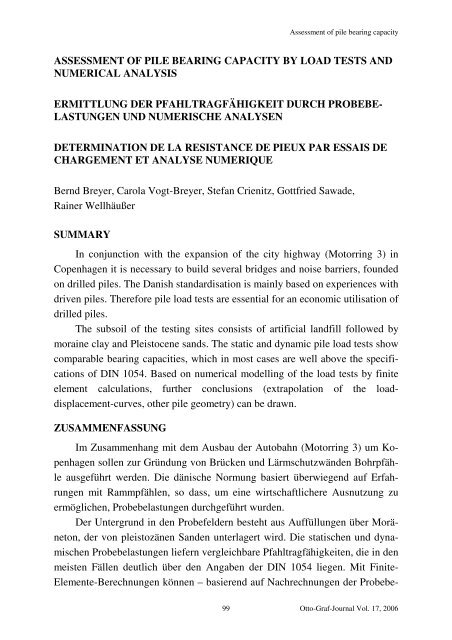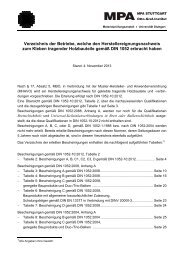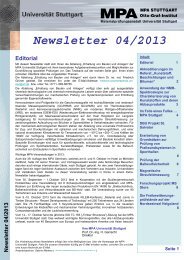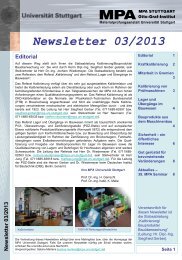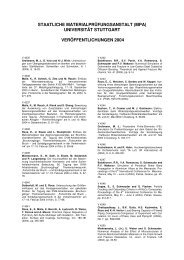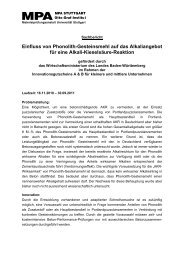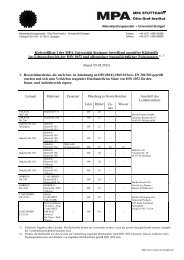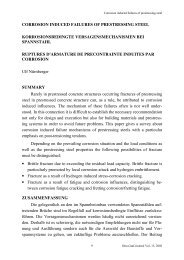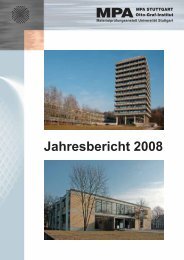beitrag breyer
beitrag breyer
beitrag breyer
Create successful ePaper yourself
Turn your PDF publications into a flip-book with our unique Google optimized e-Paper software.
Assessment of pile bearing capacity<br />
ASSESSMENT OF PILE BEARING CAPACITY BY LOAD TESTS AND<br />
NUMERICAL ANALYSIS<br />
ERMITTLUNG DER PFAHLTRAGFÄHIGKEIT DURCH PROBEBE-<br />
LASTUNGEN UND NUMERISCHE ANALYSEN<br />
DETERMINATION DE LA RESISTANCE DE PIEUX PAR ESSAIS DE<br />
CHARGEMENT ET ANALYSE NUMERIQUE<br />
Bernd Breyer, Carola Vogt-Breyer, Stefan Crienitz, Gottfried Sawade,<br />
Rainer Wellhäußer<br />
SUMMARY<br />
In conjunction with the expansion of the city highway (Motorring 3) in<br />
Copenhagen it is necessary to build several bridges and noise barriers, founded<br />
on drilled piles. The Danish standardisation is mainly based on experiences with<br />
driven piles. Therefore pile load tests are essential for an economic utilisation of<br />
drilled piles.<br />
The subsoil of the testing sites consists of artificial landfill followed by<br />
moraine clay and Pleistocene sands. The static and dynamic pile load tests show<br />
comparable bearing capacities, which in most cases are well above the specifications<br />
of DIN 1054. Based on numerical modelling of the load tests by finite<br />
element calculations, further conclusions (extrapolation of the loaddisplacement-curves,<br />
other pile geometry) can be drawn.<br />
ZUSAMMENFASSUNG<br />
Im Zusammenhang mit dem Ausbau der Autobahn (Motorring 3) um Kopenhagen<br />
sollen zur Gründung von Brücken und Lärmschutzwänden Bohrpfähle<br />
ausgeführt werden. Die dänische Normung basiert überwiegend auf Erfahrungen<br />
mit Rammpfählen, so dass, um eine wirtschaftlichere Ausnutzung zu<br />
ermöglichen, Probebelastungen durchgeführt wurden.<br />
Der Untergrund in den Probefeldern besteht aus Auffüllungen über Moräneton,<br />
der von pleistozänen Sanden unterlagert wird. Die statischen und dynamischen<br />
Probebelastungen liefern vergleichbare Pfahltragfähigkeiten, die in den<br />
meisten Fällen deutlich über den Angaben der DIN 1054 liegen. Mit Finite-<br />
Elemente-Berechnungen können – basierend auf Nachrechnungen der Probebe-<br />
99<br />
Otto-Graf-Journal Vol. 17, 2006
B. BREYER, C. VOGT-BREYER, S. CRIENITZ, G. SAWADE, R. WELLHÄUSSER<br />
lastungen – weitergehende Aussagen (Extrapolation der Widerstands-<br />
Setzungslinien, andere Pfahlgeometrien) gewonnen werden.<br />
RESUME<br />
Liés à l’expansion de l’autoroute (Motorring 3) de Copenhague, plusieurs<br />
ponts et murs antibruits, fondés sur des pieux forés, doivent être construits. La<br />
normalisation danoise se base surtout sur des expériences avec des enfoncepieux.<br />
C’est pourquoi des essais de chargement sont nécessaires pour une utilisation<br />
économique de pieux forés.<br />
Le sous-sol des terrains d’essai consiste en remblai artificiel sur de la<br />
glaise moraine et du sable pléistocène. Les essais de chargement statiques et<br />
dynamiques montrent des résistances comparables, qui en majorité sont fortement<br />
plus grandes que les données de DIN 1054. Les essais de chargement ont<br />
été récalculés avec la méthode des éléments finis. Ceci permet des conclusions<br />
élargies (extrapolation des courbes traction-déplacement, pieu d’une autre géométrie).<br />
1 DESCRIPTION OF CONSTRUCTION<br />
The city highway (Motorring 3) runs along the west side of Copenhagen<br />
and is one of the most important and busiest highways in Denmark.<br />
In summer 2003, due to regular congestion the parliament decided to expand<br />
Motorring 3 from Jægersborg to Holbæk-highway (16,2 km) from 4 to 6<br />
lanes. The road traffic department (Vejdirektorat) estimates the building costs to<br />
1,91 Billion DKR (256 Mio. Euro).<br />
In conjunction with the expansion of the city highway several bridges will<br />
be broadened or newly built and a large scale of retaining walls and noise barriers<br />
will be constructed. Due to the location in the western part of Copenhagen<br />
with nearby housing, the usual foundation method of driven piles can not be<br />
utilised. Therefore drilled piles will be used.<br />
To achieve an economic solution with this uncommon foundation method<br />
in Denmark, load tests were advertised by the technical advisor and planner of<br />
the road traffic department (COWI A/S) and contracted to Züblin Scandinavia<br />
A/S for execution.<br />
100
Figure 1: Outline map (www.vd.dk)<br />
2 DESIGN OF PILES FOLLOWING DANISH STANDARD<br />
101<br />
Assessment of pile bearing capacity<br />
With reference to Danish standard DS415 (4.1): „Norm for fundering“ the<br />
design of piles must be carried out at least according to one of the following<br />
bases:<br />
- Static pile load tests, the results of which are in harmony with other relevant<br />
experiences.<br />
- Geo-static calculation, which must be validated by static pile load tests in<br />
comparable situations.<br />
- Dynamic pile load tests (pile driving formula or Pile wave Analysis), which<br />
must be validated by static pile load tests in comparable situations.<br />
In Denmark, as a result of broad and long lasting experience, a safe and economic<br />
design of driven piles by geo-static calculations, according to the above<br />
mentioned standard, is normally possible.<br />
For compressive loading the characteristic value of the skin friction of driven<br />
concrete piles can be assessed as:<br />
τm,k = 1/1,5 . 0,4 . cu for cohesive soil and<br />
τm,k = 1/1,5 . 0,6 . qm<br />
for non-cohesive soil<br />
where qm is the vertical stress in the middle of the soil layer.<br />
The characteristic value of the base resistance can be assessed as:<br />
qs,k = 1/1,5 . 9 . cu for cohesive soil<br />
Otto-Graf-Journal Vol. 17, 2006
B. BREYER, C. VOGT-BREYER, S. CRIENITZ, G. SAWADE, R. WELLHÄUSSER<br />
If the base of driven piles is located within non-cohesive soil, a geo-static<br />
calculation of the base resistance is deemed to be so uncertain, that it may not<br />
be used for the determination of the pile bearing capacity.<br />
With reference to drilled piles the Danish standard basically says: The pile<br />
bearing capacity of drilled and cast in situ piles can be decisively smaller than<br />
the capacity of driven piles. At most 30% of the skin friction of an adequate<br />
driven pile and at most 1000 kN/m 2 as base resistance may be assumed, unless<br />
an accepted documentation of a greater bearing capacity is available. This<br />
means that the design value of the skin friction of a driven concrete pile for<br />
compressive loading within cohesive soil (e.g. cu = 100 kN/m 2 ) amounts to<br />
τmd = 1/1,3 . 1/1,5 . 0,4 . 100 kN/m 2 = 20,5 kN/m 2<br />
At most 30% of this value, i.e. a design value of the skin friction of 6,2<br />
kN/m 2 , could be assumed for an adequate drilled pile.<br />
This reveals that in many cases, due to the rare prevalence of drilled piles,<br />
the assumed values are by far on the safe side. Therefore load tests can be expected<br />
to show greater bearing capacities.<br />
3 PILE LOAD TESTS<br />
The load tests were expected to gather information about the pile bearing<br />
capacity of drilled piles for representative soil conditions of the project.<br />
For this purpose static tension and compression pile load tests were performed.<br />
In addition all piles were tested afterwards by dynamic pile load tests to<br />
gain information about the comparability of the different testing methods and to<br />
increase the reliability of the results. The aim was to optimise the diameter and<br />
length of the piles for the building project and to arrange for the potential to<br />
control the bearing capacity by further dynamic load tests.<br />
3.1 Location and geological Situation<br />
Three possible testing sites were chosen by COWI A/S. They were all situated<br />
in the middle section of the high way. According to the preceding site investigation<br />
they were regarded as representative for the whole building project.<br />
The testing sites were named as follows<br />
- test site 1 – Ørnegårdsvej<br />
- test site 2 – Nybrovej<br />
- test site 3 – Gladsaxe Ringvej<br />
102
Figure 2a: Test site 1 and 2, COWI A/S<br />
103<br />
Assessment of pile bearing capacity<br />
Figure 2b: Test site 3: Gladsaxe Ringvej,<br />
COWI A/S<br />
The geological and hydrological situation of each test site was closely investigated<br />
by a cased (0,6') exploratory drilling down to 25 m (GP-PP1) or 20 m<br />
(GB-PP2 and GB-PP3) below ground level. Cohesive soil layers were tested by<br />
field vane in order to obtain the undrained cohesion cu. Non-cohesive soil layers<br />
were tested by Standard-Penetration Tests (SPT). In addition selected soil samples<br />
were tested in the laboratory.<br />
As a result of the soil investigation the testing sites 2 and 3 were chosen<br />
for the execution of the tests. Test site 1 was discarded, owing to an ultra large<br />
layer of silt (GP-PP1), which was considered non-representative.<br />
Simplified the geological situation can be described as follows:<br />
Test site 2 (Nybrovej): The subsoil consists of artificial landfill of 1,5 m thickness,<br />
followed by senglacial sand deposits of 3 m and 7 m of moraine clay. Finally<br />
Pleistocene melt water sand was encountered down to 20 m below ground<br />
level without reaching the bottom of this layer. The groundwater table was located<br />
at about 7 m below ground level.<br />
Test site 3 (Gladsaxe Ringvej): The sequence of strata commences with 3 m of<br />
artificial landfill followed by 4,5 m of moraine clay and concludes with 12,5 m<br />
of Pleistocene melt water sand, which was encountered till the end of the drilling<br />
without reaching the bottom of this layer. The groundwater table was located<br />
at about 9,5 m below ground level.<br />
Otto-Graf-Journal Vol. 17, 2006
B. BREYER, C. VOGT-BREYER, S. CRIENITZ, G. SAWADE, R. WELLHÄUSSER<br />
Figure 3a: Geology and pile length at test<br />
site 2 (Nybrovej), COWI A/S<br />
Table 1: Test schedule<br />
104<br />
Figure 3b: Geology and pile length at test<br />
site 3 (Gladsaxe Ringvej), COWI A/S<br />
Pile PP 1.1 1.2 1.3 2.1 2.2 2.3<br />
Length [m] 8,0 10,0 17,0 7,5 10,0 17,0<br />
Compression load [MN] (stat.) > 1,5 > 1,8 3,0 - > 2,55 3,0<br />
Tensile load [MN] (stat.)<br />
-<br />
Dyn. pile load test x x x x x x<br />
3.2 Concept of load tests<br />
><br />
0,83<br />
At both test sites three test piles of 770 mm diameter were produced. The<br />
particular pile lengths and their position relative to the geological layers are<br />
shown in Figure 3a and 3b. The test program is summarised in Table 1.<br />
For the determination of the load transfer along the shaft of the pile, test<br />
piles PP 1.3 and PP 2.3 were equipped at 5 cross sections with 4 vibrating wire<br />
strain gauges each. Layers 1 and 2 were arranged at ground level and base level<br />
of the moraine clay. Layers 3 to 5 were evenly distributed over the embedded<br />
length within the melt water sand.<br />
><br />
1,8<br />
><br />
1,0<br />
><br />
1,4<br />
2,1
Assessment of pile bearing capacity<br />
In addition test pile PP 1.3 was equipped with 3 sensors for the measurement<br />
of the temperature of the concrete. The sensors were arranged at 65 mm,<br />
175 mm and 285 mm from the centre of the pile at about 10 m depth.<br />
The maximum test loads for all test piles had been predefined to 3000 kN<br />
for compressive loading and 2100 kN for tensile loading. The testing abutment<br />
had been designed accordingly.<br />
3.3 Arrangement and production of the test piles and testing abutment<br />
At both test sites the test piles were arranged in a row at a distance of 6,60<br />
m, reducing the costs and effort for the testing abutment, because parts of the<br />
tensile and compressive elements could be used for two pile tests.<br />
All test piles were reinforced by one reinforcement cage for the whole<br />
length of the pile. The transmission of the tensile loading into the short piles PP<br />
1.2, PP 2.1 and PP 2.2 was effected starting at the top of the pile by GEWI-bars<br />
(2 x 63,5 mm) with a total bonding length of 5,6 m. In contrast, the transmission<br />
of the tensile loading into the long piles PP 1.3 and PP 2.3 was performed starting<br />
at the base of the pile. For this, two GEWI-bars were directed through cladding<br />
tubes and anchored at the base of the pile.<br />
The head of the pile was reinforced by a casing pipe of 1,2 m diameter and<br />
0,5 m height.<br />
Figure 4a: Test apparatus for compression<br />
test<br />
105<br />
Figure 4b: Test apparatus for tension test<br />
The testing abutment consisted of reinforced steel girders, 2 HE-M 1000 as<br />
main beams and 2 HE-B 650 as auxiliary beams. The reaction forces, resulting<br />
from the tensile and compressive loading of the test piles, were transferred into<br />
Otto-Graf-Journal Vol. 17, 2006
B. BREYER, C. VOGT-BREYER, S. CRIENITZ, G. SAWADE, R. WELLHÄUSSER<br />
the ground by strip foundations (3,00 m x 1,25 m x 0,50 m) or by 4 GEWI-piles<br />
(GEWI 50, 15 m length).<br />
In August 2004, the test piles were installed by cased drilling (double<br />
walled casing of 750 mm diameter) according to DS/EN 1536. The drilling rig<br />
used was a Liebherr LRB 155.<br />
The GEWI-piles for the testing abutment were installed by overburden<br />
drilling of 133 mm diameter.<br />
3.4 Implementation of the tests<br />
The set-up of the test and the measuring equipment matched the “Recommendations<br />
for Static and Dynamic Pile Tests” of working group 2.1 of the<br />
German Society for Geotechnics. Test piles 1.1, 1.2, 2.1 and 2.2 were tested according<br />
to level 1 (lower requirements) and test piles 1.3 and 2.3 according to<br />
level 3 (higher requirements). The static pile load tests were carried out by<br />
MPA, University of Stuttgart, the dynamic pile load tests were performed by<br />
GSP, Mannheim.<br />
3.4.1 Implementation of the static pile load tests<br />
The test load was applied by four hydraulic jacks (hydraulically coupled)<br />
and was held constant by an automatic load-maintaining pump, which was regulated<br />
by an electrical pressure gauge. In addition the load was controlled by four<br />
electrical load cells.<br />
The vertical displacement of the piles was registered by 2 electrical displacement<br />
transducers and 2 mechanical dial gauges (metering precision / reading<br />
accuracy 1/100 mm), which were arranged diametrically opposed at the<br />
head of the piles. The transducers and dial gages were mounted on a long measuring<br />
bridge, built of two parallel arranged formwork girders, the support of<br />
which were outside of the expected area of influence of the test pile and the reaction<br />
supports.<br />
The vertical displacement was controlled independently of this measurement<br />
by a digital level (1/100 mm accuracy).<br />
The whole test equipment was sheltered from climatic effects by an overall tent<br />
and the control and measuring electronics were housed in an office container.<br />
Each load step was held constant until at least the defined minimum waiting<br />
time was reached, the creep ratio ks = (s2-s1) / log(t2/t1) had been assessed<br />
106
Assessment of pile bearing capacity<br />
reliably and the predetermined rate of displacement had decreased to less than<br />
0,1 mm / 20 min over a period of one hour.<br />
All load changes were carried out slowly (quasi-static). After each unloading<br />
to the initial load the displacement was observed at least for 30 min until the<br />
rate of rebound had essentially ceased<br />
Figure 5: Test apparatus for dynamic test<br />
3.4.2 Implementation of the dynamic pile load test<br />
The dynamic pile load tests were carried out only few days after the static<br />
pile load tests.<br />
The impact loading was induced by a frame guided weight of 6 tons with<br />
variable height of fall. The whole equipment was placed on a working platform<br />
of two large I-beams above the test pile.<br />
Two strain and two acceleration transducers were mounted diametrically<br />
opposed on both sides of the pile. Two planes had been prepared on the surface<br />
of the piles about 0,6 m below the pile head for this purpose. In addition the residual<br />
displacements were optically controlled.<br />
During the pile load test 5 to 8 impacts with increasing height of fall were<br />
carried out. By that process the uplift caused by the static pile load test under<br />
tensile loading was successively compensated.<br />
The measured signals were processed and recorded by the Pile Driving<br />
Analyser, model PAK of Pile Dynamics Inc., Cleveland.<br />
107<br />
Otto-Graf-Journal Vol. 17, 2006
B. BREYER, C. VOGT-BREYER, S. CRIENITZ, G. SAWADE, R. WELLHÄUSSER<br />
3.5 Results and evaluation<br />
3.5.1 Results and evaluation of the static pile load tests<br />
The static pile load tests could generally be carried out according to the<br />
predetermined loading programs. Only three load tests had to be aborted prematurely.<br />
The displacement of Piles 1.1D and 2.1Z had by far passed the limit of<br />
77 mm (stop criterion 1/10 of pile diameter). During the load test of pile 1.3Z,<br />
the auxiliary load beams above the hydraulic jacks had turned unacceptably<br />
around it’s longitudinal axis.<br />
Test load[kN]<br />
3000<br />
2500<br />
2000<br />
1500<br />
1000<br />
500<br />
60 kN<br />
0<br />
750 kN<br />
375 kN<br />
1125 kN<br />
KMD1<br />
KMD2<br />
KMD3<br />
KMD4<br />
Test load<br />
1500 kN<br />
1500 kN<br />
1875 kN<br />
2250 kN 2250 kN<br />
2625 kN<br />
3000 kN<br />
2 4 6 8 10 12 14 16 18<br />
Duration of test [h]<br />
Skin friction [kN/qm]<br />
120<br />
100<br />
80<br />
60<br />
40<br />
20<br />
0<br />
Vertikal displacement of pile head [mm]<br />
0 2 4 6 8 10 12 14 16 18<br />
Position below top of pile head (28,30 m DNN) [m]<br />
108<br />
0<br />
2<br />
4<br />
6<br />
8<br />
0 500 1000 1500 2000 2500 3000<br />
Test load [kN]<br />
Figure 6: Typical graphs of loading program, load-displacement curve and distribution of the<br />
activated skin friction at all load steps for the compression test at pile PP 2.3<br />
No significant horizontal displacements or inclinations of the pile head<br />
were noticed during the tests, so that any adverse effects on the measurements<br />
due to eccentric loading or an unscheduled bending moment could be excluded.<br />
3000<br />
kN 2250<br />
kN 1500<br />
kN 750<br />
kN
109<br />
Assessment of pile bearing capacity<br />
The load-displacement behaviour and creep behaviour could be determined.<br />
In addition to that the distribution of the activated skin friction could be<br />
determined at the piles PP 1.3 and PP 2.3.<br />
In Figure 6 typical graphs of loading program, load-displacement curve<br />
and distribution of the activated skin friction at all load steps for a compression<br />
test are shown. In Figure 7 all load-displacement-curves for the static load tests<br />
are shown, simplified without unloading and reloading.<br />
Axial load [kN]<br />
3500<br />
3000<br />
2500<br />
2000<br />
1500<br />
1000<br />
500<br />
Static pile load tests<br />
0<br />
0 40 80 120<br />
Vertical displacement of pile head [mm]<br />
PP1.1D<br />
PP1.2D<br />
PP1.2Z<br />
PP1.3D<br />
PP1.3Z<br />
Figure 7a: Load-displacement-curves of all piles at test site 2 (Nybrovej)<br />
Axial load [kN]<br />
3500<br />
3000<br />
2500<br />
2000<br />
1500<br />
1000<br />
500<br />
Static pile load tests<br />
0<br />
0 40 80 120<br />
Vertical displacement of pile head [mm]<br />
PP2.1Z<br />
PP2.2D<br />
PP2.2Z<br />
PP2.3D<br />
PP2.3Z<br />
Figure 7b: Load-displacement-curves of all piles at test site 3 (Gladsaxe Ringvej)<br />
3.5.2 Results and evaluation of the dynamic pile load tests<br />
All dynamic load tests were carried out according to the planned procedure.<br />
Otto-Graf-Journal Vol. 17, 2006
B. BREYER, C. VOGT-BREYER, S. CRIENITZ, G. SAWADE, R. WELLHÄUSSER<br />
Additional displacement [mm]<br />
Load [kN] Load [kN]<br />
Addotional displacement [mm]<br />
Figure 8: Load-displacement-curves calculated from dynamic load tests (evaluated blow<br />
only)<br />
The evaluation of the measurements was carried out with CAPWAP<br />
(CASE Pile Wave Analysis Program). In this process a computer-modelled pile<br />
in the subsoil is altered in an iterative procedure to optimise the correspondence<br />
of the calculated and the measured time responses of the pile head velocity. In<br />
an additional step with this optimised computer-model static loadings (i.e. loaddisplacement<br />
curves) are simulated, and a respective distribution of the skin<br />
friction is determined.<br />
3.5.3 Comparison of the results of the static load tests with the dynamic load<br />
tests<br />
In the following table the max. test load resp. the max. calculated load capacity<br />
and the corresponding displacements are shown for the static and the dynamic<br />
load tests. The second displacement value gives the total displacement<br />
including the displacements from previous load tests.<br />
At the long piles 1.3 and 2.3, which are embedded in good bearing sand<br />
the ultimate bearing capacity was neither reached at the tension test nor at the<br />
compression test. The higher values (compression) of the dynamic tests are<br />
therefore plausible.<br />
The load-displacement behaviour of the middle-long piles 1.2 and 2.2,<br />
which are only embedded marginally in good bearing sand, was significantly<br />
softer.<br />
However only at pile 1.2 was the ultimate bearing capacity approximately<br />
reached at the tension test. The somewhat higher values (compression) of the<br />
dynamic tests are therefore plausible.<br />
At the short piles 1.1 and 2.1 the ultimate bearing capacity was clearly<br />
reached or exceeded. In consideration of the preceding displacements from pre-<br />
110
Assessment of pile bearing capacity<br />
vious load tests the correspondence with the dynamic results at pile 1.1 is nevertheless<br />
good.<br />
Table 2: Comparison of the static load tests with the dynamic load tests<br />
PP Form of test<br />
1.1<br />
1.2<br />
1.3<br />
2.1<br />
2.2<br />
2.3<br />
max. test load /<br />
load capacity<br />
111<br />
Accumulated displacement<br />
of the<br />
pile head [mm]<br />
Creep<br />
[mm]<br />
Stat. (compression) 2063 kN ~104 9,21<br />
Dyn. (Blow 2/5) * 1846 kN<br />
8 resp.<br />
~112<br />
Stat. (Compression) 3000 kN 15,44 1,16<br />
Stat. (Tension) 2100 kN<br />
-57,13 resp.<br />
-41,69<br />
Dyn. (Blow 8/8) 3172 kN 73 resp. 31,31 -<br />
Otto-Graf-Journal Vol. 17, 2006<br />
-<br />
10,55<br />
Stat. (Compression) 3000 kN 9,41 0,54<br />
Stat. (Tension) 1800 kN ** -9,21 resp. 0,20 0,34<br />
Dyn. (Blow 6/6) 3764 kN 17 resp. 17,2 -<br />
Stat. (Tension) 1367 kN -109,80 � ∞<br />
Dyn. (Blow 8/8) 2422 kN 163,5 resp. 53,70 -<br />
Stat. (Compression) 3000 kN 14,91 1,05<br />
Stat. (Tension) 2100 kN<br />
-25,36 resp.<br />
–10,45<br />
Dyn. (Blow 7/7) 3443 kN 54 resp. 43,55 -<br />
4,26<br />
Stat. (Compression) 3000 kN 8,04 0,64<br />
Stat. (Tension) 2100 kN -8,31 resp. –0,27 0,33<br />
Dyn. (Blow 5/7) 3785 kN 17,5 resp. 17,23 -<br />
* (Blow 2/5): 2. Blow of 5 blows altogether<br />
** preliminary abortion due to tilted load beam<br />
4 FINITE-ELEMENT-CALCULATION<br />
By means of a comparative calculation of the pile resistance with the finite-element<br />
method (FEM) it is shown what prediction can be made with FEM,<br />
what additional information can be gained, and where, in this case, the applications<br />
limitations lie.
B. BREYER, C. VOGT-BREYER, S. CRIENITZ, G. SAWADE, R. WELLHÄUSSER<br />
The calculations were carried out with the Plaxis program. The pile and the<br />
surrounding soil were modelled as a rotation-symmetrical problem. The mesh<br />
used is displayed in Figure 9.<br />
The elements used are triangle shaped wit 15 knots and a displacement<br />
ansatz of 4 th order.<br />
Figure 9: Finite-element-mesh for a 17m pile at test site Nybrovej<br />
The input data for the layers of soil were taken from the geotechnical report<br />
from COWI A/S.<br />
The load-displacement behaviour of the subsoil was approximated with the<br />
accepted linear-elastic elasto-plastic constitutive equations from Mohr-<br />
Coulomb.<br />
With Plaxis one could use constitutive equations to cover the elastoplastic<br />
soil behaviour even more realistically. To do so one requires further soil parameters,<br />
that are commonly not specified in geotechnical reports. This means<br />
that the accuracy of the results is not improved if one uses a constitutive equation<br />
of a higher order but can estimate the necessary additional parameters only<br />
roughly.<br />
For the cohesive soil layers the used shear strength parameters used for the<br />
calculations were obtained by vane shear tests. For the cohesionless soil layers<br />
the parameters were obtained by standard penetration tests.<br />
Both tests were carried out in-situ, in the borehole, in almost undisturbed<br />
soil. The modulus of elasticity of the different soil layers was estimated on the<br />
basis of existing empirical values for those soils. For each test site the calcula-<br />
112
Assessment of pile bearing capacity<br />
tions of the pile load tests for different pile lengths were carried out with a uniform<br />
set of soil parameters. For the modulus of elasticity of the piles themselves,<br />
the linear elastic stiffness of concrete was applied.<br />
Layer<br />
Table 3: Input data for soil parameters<br />
ϕ´<br />
[ o ]<br />
Test site<br />
Nybrovej<br />
cu<br />
[kPa]<br />
113<br />
Es<br />
[Mpa]<br />
ϕ´<br />
[ o ]<br />
Test site<br />
Gladsaxe Ringvej<br />
cu<br />
[kPa]<br />
Es<br />
[Mpa]<br />
Backfilling / Sand 30 - 10 30 - 10<br />
Moraine clay (top) - 248 40 - 276 40<br />
Moraine clay (bottom) - 165 30 - 474 60<br />
Moraine sand - - 60 32,5 - 60<br />
Melted snow and ice sand 35 - 100 35 - 100<br />
Due to the drilling process the high values for the consolidated undrained<br />
cohesion of the in-situ layers can be decreased considerably at the interface<br />
pile-soil. In the German DIN-standards this is taken into account. There only<br />
50% resp. 30% of high undrained cohesion values are allowed to be applied for<br />
the characteristic skin friction. Therefore the finite-elements calculations were<br />
performed for each pile with 100% undrained cohesion as well as 50%<br />
undrained cohesion values. Due to the slow performance of the tests, an appearance<br />
of pore water pressure was not taken into account. For the non-cohesive<br />
soil layers none of this variation was carried out but a uniform shear strength<br />
was applied.<br />
The calculations were carried out as CPR-tests (constant rate of penetration).<br />
This means that a displacement is induced incrementally up to 100 mm<br />
while the required axial load is plotted over the displacement of the pile head.<br />
In the computed simulations only piles under a compression load were considered.<br />
The calculated load-displacement curves are shown in Figure 10.<br />
The advantage of a FEM calculation in combination with pile load tests is<br />
that one can verify the data input on the basis of the test results. Other pile dimensions<br />
can easily be analysed numerically. Due to specific technical reasons<br />
(abutment), the ultimate bearing capacity was not reached with all piles. By<br />
means of the FEM calculations the ultimate bearing capacity could be narrowed<br />
down.<br />
Otto-Graf-Journal Vol. 17, 2006
B. BREYER, C. VOGT-BREYER, S. CRIENITZ, G. SAWADE, R. WELLHÄUSSER<br />
5 COMPARISON PILE LOAD TEST – FEM CALCULATION -<br />
STANDARDS<br />
To compare the results of the static and dynamic load tests with the FEM<br />
calculations and with the German and Danish standards, the following curves<br />
for a pile ( Ø =770 mm, compression test) were plotted in Figure 10:<br />
- measured load-displacement curve from static load test<br />
- calculated load-displacement curve from dynamic load test<br />
- load-displacement curve from FEM calculation with 100% undrained cohesion<br />
value for cohesive layers<br />
- load-displacement curve from FEM calculation with 50% undrained cohesion<br />
value for cohesive layers<br />
- calculated load-displacement curve with input values from the German standard<br />
DIN 1054<br />
- calculated bearing capacity with input values from Danish the standard DS<br />
415. According to this standard a geo-static calculation of the end bearing<br />
capacity in cohesive soils would be considered as unsure. However, for a<br />
comparison of bearing capacities the use of empirical values is expedient. In<br />
this case the max. value given in this standard of qd = 1000 kPa was proper<br />
Axial load [kN]<br />
1,2<br />
1<br />
0,8<br />
0,6<br />
0,4<br />
0,2<br />
6000<br />
5000<br />
4000<br />
3000<br />
2000<br />
1000<br />
0<br />
Static pile load test<br />
Dynamic pile load test<br />
FEM, 100% cu<br />
FEM, 50 % cu<br />
DIN 1054<br />
DS 415<br />
Axial load [kN]<br />
0<br />
0 20 40 60 80<br />
Vertical displacement of pile head [mm]<br />
3500<br />
3000<br />
2500<br />
2000<br />
1500<br />
1000<br />
500<br />
0<br />
0 20 40 60 80<br />
Figure 10a: Pile PP1.1<br />
114<br />
Axial load [kN]<br />
Vertical displacement of pile head [mm]<br />
10000<br />
8000<br />
6000<br />
4000<br />
2000<br />
0<br />
0 20 40 60 80<br />
Vertical displacement of pile head [mm]<br />
Figure 10b: Pile PP1.2 Figure 10c: Pile PP1.3
Axial load [kN]<br />
8000<br />
6000<br />
4000<br />
2000<br />
0<br />
0 20 40 60 80<br />
Vertical displacement of pile head [mm]<br />
115<br />
12000<br />
9000<br />
6000<br />
3000<br />
Assessment of pile bearing capacity<br />
0<br />
0 20 40 60 80<br />
Vertical displacement of pile head [mm]<br />
Figure 10d: Pile PP2.2 Figure 10e: Pile PP2.3<br />
Figure 10: Comparative load-displacement curves<br />
The comparative plot shows that in most cases the bearing capacity of the<br />
static and dynamic load tests lie between the results of the FEM calculations<br />
with 50 % and 100 % undrained cohesion value.<br />
The test results exceed the values in the German standard DIN 1054 in<br />
most cases. Though, particularly with regard to the results of pile PP2.3 one can<br />
clearly see that the standard gives an appropriate lower limit.<br />
As one could expect for the previously mentioned reasons, the calculated<br />
bearing capacities with input values from the Danish standard DS 415 lie decidedly<br />
below the test results.<br />
6 CONCLUSIONS<br />
The described static pile load tests provide a good basis for an economical<br />
dimensioning of bored piles, for the expansion of the city highway Motorring 3<br />
in Copenhagen. The load-displacement curves of all six tests show a coherent<br />
image that were reconfirmed by the dynamic load tests. As a result further dynamic<br />
tests in the course of the construction work are possible.<br />
The in-situ proved bearing capacities exceed the values according to German<br />
standard DIN 1054 in most cases. In consideration of the margin of deviation<br />
the standard gives an appropriate lower limit.<br />
A geo-static calculation of the bearing capacity according to the Danish<br />
standard DS 415 gives very conservative results. Therefore pile load tests for<br />
extensive building projects are of financial benefit, especially if the pile toe lies<br />
in cohesive soil.<br />
With FEM calculations and the soil parameters from the geotechnical report,<br />
a well fitted mathemathical model of the load bearing behaviour could be<br />
found.<br />
Axial load [kN]<br />
Otto-Graf-Journal Vol. 17, 2006
B. BREYER, C. VOGT-BREYER, S. CRIENITZ, G. SAWADE, R. WELLHÄUSSER<br />
Regarding the determination of ultimate bearing capacities, a limiting consideration<br />
with the use of 50% resp. 100% of the cohesion values as a lower<br />
resp. upper limit is recommended.<br />
7 BIBLIOGRAPHY<br />
Pile load test report from MPA-University of Stuttgart 55120/9008358, 10-2004<br />
Website of Vejdirektorat (Danish highway board department): www.vd.dk<br />
Geotechnical report from COWI A/S: Vejdirektoratet O3 Motorring 3, Borede<br />
prøvepæle, Geoteknisk datarapport, 08-2004<br />
Pile load test report from Züblin Scandinavia A/S: København – Motorring 3,<br />
Rapport vedr. borede prøvepæle, 11-2004<br />
DS 415(4.1): Norm for fundering (1998)<br />
Danish standard DS/EN 1536: Udførelse af særlige geotekniske konstruktioner.<br />
Borede pæle. (1999)<br />
German standard DIN 1054: Baugrund. Sicherheitsnachweise im Erd- und<br />
Grundbau (2003)<br />
Recommendations for static and dynamic pile tests from the German society for<br />
geotechniques, working group 2.1 (1998)<br />
Plaxis V8 users manual (2003)<br />
116


